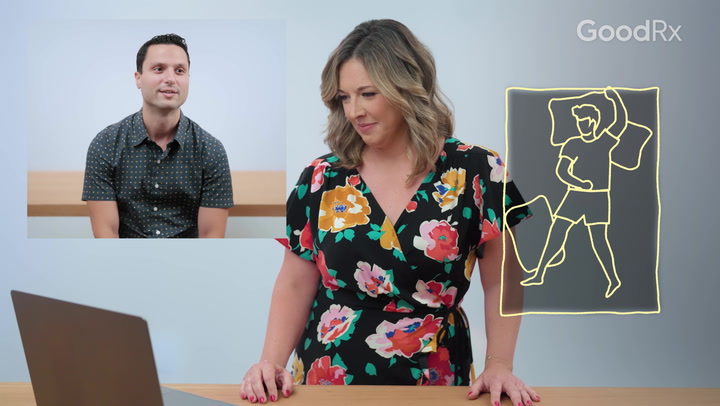
These Are the Best Sleeping Positions for Peripheral Artery Disease
Key takeaways:
Peripheral artery disease (PAD) causes symptoms –– such as pain and cramping in your legs –– that make it difficult to get a restful sleep.
The best sleeping positions for peripheral artery disease should increase circulation. For example, sleeping on your back with your head elevated can improve blood flow to your legs and feet through gravity.
If you have severe PAD, elevating your legs during sleep may worsen symptoms. Instead, try keeping your legs lower than your heart by raising the head of the bed.

If you’re one of the millions of people living with peripheral artery disease (PAD), getting quality sleep can be a challenge. PAD occurs when arteries become narrowed or blocked, restricting blood flow to your arms, legs, and organs. Atherosclerosis, or buildup of cholesterol deposits in the arteries, is the primary cause of PAD.
Reduced blood flow with PAD can cause cramping or pain in your legs and feet. Sometimes, leg pain happens when you’re resting, making it difficult to fall asleep. It's important to talk with a healthcare professional about any recurring leg pain. Adjusting your sleeping position can also help.
What are the best sleeping positions for peripheral artery disease?
You might have a favorite sleep position. But when you’re dealing with leg pain at night due to PAD, some sleeping positions may be more helpful than others. Let’s take a closer look at the best sleeping positions for peripheral artery disease.
Search and compare options
Sleep on your back with your head elevated
The reduced blood flow that occurs in PAD can cause pain in the legs, especially at night. Lying on your back with your head elevated might reduce discomfort.
When you sleep with your head elevated, your heart is higher than your legs. Gravity then works in your favor by assisting blood flow down to your feet, Trisha Roy, MD, a vascular surgeon at Houston Methodist, told GoodRx Health. Elevating your head and heart above your legs can also ease the pain associated with poor blood flow, Roy said.
To achieve this position:
Lie on your back.
Use extra pillows to prop up your head and upper body.
A wedge pillow may also work well because it creates a gradual slope to raise your head and upper body while you sleep. You might also consider investing in an adjustable bed that lets you raise the top half of the mattress. Experiment with different heights to find the most comfortable position.
If a new mattress isn’t in your budget, you can also place a block under the head end of the bed frame or mattress.
Sleep on your back
If sleeping on your back with your head elevated is uncomfortable, lying flat on your back may help.
Read more like this
Explore these related articles, suggested for readers like you.
Lying on your back evenly distributes your body weight across the surface. This equal distribution helps you avoid putting excess pressure on any part of your body, which is particularly important for people with PAD. Too much pressure can compress your blood vessels and reduce blood flow to the affected areas.
Here’s what to do:
Lie on your back.
Tuck a pillow under your knees to support your spine’s natural curve.
Try putting a pillow under your lower back for extra support.
“People with peripheral artery disease typically benefit from sleeping positions that avoid pressure on the heels,” Roy explained. Constant pressure on the heels can cause skin injuries and sores. And it’s hard for them to heal without good blood flow. Placing a cushion under your legs can help raise your heels off the mattress and avoid pressure.
However, some people with PAD may develop other diseases related to plaque buildup, such as sleep apnea. Sleep apnea is a common condition where your breathing repeatedly stops and starts during sleep. You should avoid sleeping on your back if you have sleep apnea. In this sleep position, your soft palate and tongue can block your airway, worsening the condition. You’re also more likely to snore, which can disrupt your sleep. If you have PAD and sleep apnea, try sleeping on your side instead.
Sleep on your side with a pillow between your legs
If you’re a side sleeper, you may not have to change your sleep habits to manage PAD symptoms. “This position helps align the spine and improves blood flow,” Chelsea Perry, DMD, owner of Sleep Solutions, told GoodRx Health.
However, there’s a downside. When you sleep on your side with one leg directly on top of the other, the weight of the top leg can put pressure on the bottom one. The pressure can constrict the blood vessels in your legs and limit blood flow.
To prevent this, place a pillow between your legs while sleeping on your side, Perry said. The pillow cushions the legs and keeps your spine in a neutral alignment. It also allows blood to flow more freely through your legs and feet, which can help alleviate symptoms of PAD, such as pain, numbness, and tingling.
To sleep in this position:
Lie on your side.
Keep your legs straight or slightly bend your knees.
Tuck a pillow lengthwise between your knees and ankles.
You may also want a supportive pillow for your head and neck.
PAD vs. CVI: Peripheral artery disease (PAD) is often confused with chronic venous insufficiency (CVI). Learn about the differences between PAD and CVI and how to tell them apart.
Benefits of walking: Walking is the best exercise to prevent peripheral artery disease and improve its symptoms. Find out how to add walking to your routine.
Sleep and PAD: Good sleep hygiene is helpful for quality sleep when you have peripheral artery disease. Try these tips for better rest.
Should you elevate your legs when you have peripheral artery disease?
It depends on the severity of your PAD and whether you experience certain symptoms. “People with mild or moderate PAD can safely sleep in any position without concern for aggravating their condition,” said William P. Shutze, MD, a board-certified vascular surgeon based in Texas.
However, for those with severe PAD, elevating the legs during sleep may worsen their condition, Shutze told GoodRx Health. The position may limit already poor blood flow to the legs.
Severe PAD may cause you to wake up at night with one or both feet hurting. This can happen even if your legs were resting neutral on the bed, without being elevated, he said.
Symptoms of severe PAD include:
Intense pain, tingling, or numbness in your feet or toes, even from light touch
Pain that worsens when you raise your legs but improves when you dangle them over the side of the bed
Darkening or bluish color of your skin
Sores on your feet that won't heal
Erectile dysfunction
In this case, try sleeping with your legs in a dependent position. This means keeping them lower than your heart, Shutze said. You can do this by sleeping on your back and elevating the head of your bed.
Severe foot pain at night may indicate that your blood flow is critically low. This could put you at risk of serious complications like losing your leg. In this case, Shutze advised consulting with a vascular surgeon immediately.
Leg swelling is another factor to consider. Most people with swollen legs and feet are told to sleep with their feet elevated. However, Shutze said PAD itself usually doesn’t cause swelling unless you constantly keep your feet in a dependent position due to pain.
Other tips to alleviate discomfort from PAD
Managing PAD requires more than just finding the ideal sleep position. Here are some additional tips to help improve your comfort, especially when sleeping.
Try heel protectors. Roy recommends using heel protectors to reduce pressure on your heels. She also suggests regularly checking your feet and seeking medical attention if any wound develops, as PAD can make healing difficult.
Be careful with heating pads and heating blankets. These warming devices can easily cause burns on your feet when you have PAD and reduced blood flow, Shutze said.
Avoid certain positions. “Avoid sleeping in positions that compress blood vessels, such as crossing your legs,” Perry said. Other examples include sleeping on your stomach or in a fetal position. This sleep position can restrict blood flow and worsen PAD symptoms.
Additional steps to manage PAD include:
Maintain a comfortable weight.
If you smoke, quit smoking.
Manage your blood pressure and cholesterol.
Take your medications as prescribed.
Frequently asked questions
Maintaining an active lifestyle is a great way to manage the risk factors of peripheral artery disease (PAD), such as high cholesterol and having overweight. But if you have an open wound or sore area, it’s best to avoid any exercise that might irritate it or worsen it. Remember to talk with a healthcare professional before starting any exercise routine.
Walking is the best exercise for PAD. It helps improve blood flow in the legs and feet, and helps the body grow new blood vessels. A study found that a 6-month supervised walking program allowed people with PAD to walk farther than those who had surgery or didn’t exercise.
Compression socks apply pressure to your legs and ankles to help push blood up your legs toward your heart. In doing so, compression socks may make it more difficult for blood to flow to your legs and feet, potentially worsening existing PAD. Consult a healthcare professional if you have PAD and have been wearing compression socks to reduce swelling or prevent blood clots.
The bottom line
The best sleeping positions for people with peripheral artery disease (PAD) are lying on your back with your head elevated, lying flat on your back, or sleeping on your side with a pillow between your legs. These positions can help improve blood flow to your legs and feet, and reduce discomfort.
However, if you have severe PAD, elevating your legs during sleep may worsen your symptoms. In this case, try sleeping with your legs lower than your heart by raising the head of the bed. If you experience severe foot pain at night or have any symptoms of PAD, talk with a healthcare professional.
Why trust our experts?



References
American Heart Association. (2024). Prevention and treatment of PAD.
American Heart Association. (2024). Symptoms of PAD.
Centers for Disease Control and Prevention. (2024). About peripheral arterial disease (PAD).
Desouzart, G. et al. (2016). Effects of sleeping position on back pain in physically active seniors: A controlled pilot study. Work.
Joosten, S. A., et al. (2014). Supine position related obstructive sleep apnea in adults: Pathogenesis and treatment. Sleep Medicine Reviews.
MedlinePlus. (2022). Peripheral artery disease - legs.
Murphy, T. P., et al. (2012). Supervised exercise versus primary stenting for claudication resulting from aortoiliac peripheral artery disease: Six-month outcomes from the (CLEVER) study. Circulation.
Schahab, N., et al. (2017). Sleep apnoea is common in severe peripheral arterial disease. PloS One.
Skarpsno, E. S., et al. (2017). Sleep positions and nocturnal body movements based on free-living accelerometer recordings: Association with demographics, lifestyle, and insomnia symptoms. Nature and Science of Sleep.
Uccioli, L., et al. (2018). Critical limb ischemia: Current challenges and future prospects. Vascular Health and Risk Management.
Zemaitis, M. R., et al. (2023). Peripheral arterial disease. StatPearls.




























